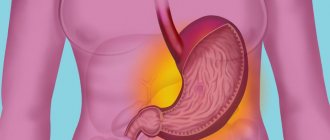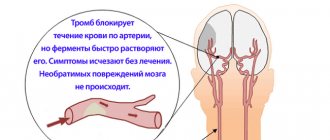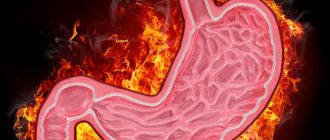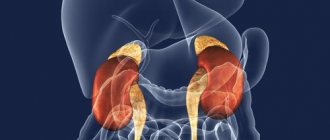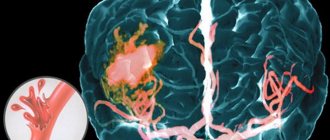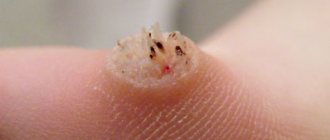Myocardial cardiosclerosis is caused by exposure to prolonged hypoxia on the body, which is associated with vascular atherosclerosis and coronary heart disease, as well as exposure to infectious agents and autoimmune processes. In this case, the patient experiences replacement of cardiomyocytes with scar tissue. Cardiac hypertrophy, chest pain, weakness and acute cardiovascular failure develop. Insufficient or untimely treatment can result in death.
A characteristic sign of cardiosclerosis is a weakening of heart sounds and a change in pulse strength.
Development mechanism
Most often, PICS is based on the development of myocardial infarction, which means the death of a healthy section of the heart muscle.
In this case, a focus of necrosis is formed containing dead cardiomyocytes (contractile myocardial cells). Mechanisms are activated in the body aimed at removing necrotic masses. In parallel, a restoration process occurs, which is accompanied by the appearance of “special” fibroblast cells (connective tissue cells). They synthesize connective tissue components, thus replacing the area of dead muscle with fibrous tissue. The formation of large-focal or small-focal cardiosclerosis occurs.
Since the heart continues to perform its usual function - pumping blood to organs and tissues, but part of the heart muscle has died, the load on an individual cell increases significantly and an increase in contractile cells develops (hypertrophy), and then an expansion of the cavities of the heart. Thus, remodeling occurs, which means a change in the structure, shape and function of the heart.
Since after myocardial infarction, part of the muscle is replaced by connective tissue, the processes of normal conduction of impulses may be disrupted (when connective tissue is localized in various parts of the conduction system of the heart - sinus node, atrioventricular node) and uncharacteristic foci of electrical activity may appear (usually at the border of normal myocardium and scar).
In parallel with the formation of cardiosclerosis, changes occur in neurohumoral systems, which initially have a positive compensatory effect, and then cause decompensation of cardiac activity with the development of chronic heart failure.
Classification
Types depending on the location and intensity of connective tissue proliferation:
- Focal cardiosclerosis . This form of the disease is characterized by the appearance of individual scar formations in the tissues of the heart. Most often, the focal form appears after myocarditis or myocardial infarction.
- Diffuse cardiosclerosis . In this form of the disease, connective tissue is formed evenly over the entire area of the myocardium. Usually occurs as a complication of chronic ischemia or after toxic or infectious lesions of the heart.
Depending on the cause of its occurrence, cardiosclerosis is divided into the following forms:
- Atherosclerotic. It is formed as a result of diseases that cause hypoxia of cardiac muscle cells - most often due to chronic cardiac ischemia.
- Post-infarction. As a result of a heart attack, extensive death of cardiomyocytes occurs, in the place of which connective tissue appears.
- Myocardial. Formed due to inflammatory processes in the tissues of the main organ.
In rare cases, cardiosclerosis may be congenital . This type of disease can occur as a consequence of other congenital heart pathologies - for example, subendocardial fibroelastosis or collagenosis.
Causes
The main cause of PICS is myocardial infarction. In turn, the cause of a heart attack is a violation of blood flow due to complete or incomplete closure of the lumen of the arteries of the heart.
Lead to the development of myocardial infarction:
- instability of atherosclerotic plaque - erosion, rupture, crack;
- spasm or embolism of the arteries of the heart;
- heart rhythm disturbances;
- increased blood pressure;
- rare causes - congenital changes in the arteries of the heart, a decrease in the lumen of blood vessels, diseases associated with metabolic disorders, heart injuries, connective tissue diseases.
https://youtu.be/WSYe-i7D4Cg
Reasons for development
Cardiosclerosis occurs as a result of prolonged hypoxia of myocardial tissue due to blockage of a vessel by an atherosclerotic plaque or thrombus, followed by processes of exudation and proliferation of connective tissues. In this regard, scar tissue or fibrous cords form in place of the cardiomyocytes, which are unable to perform the functions of muscle fibers and contract. As a result of compensatory mechanisms, the heart increases significantly in size, which is associated with hypertrophy of the remaining myocardium, since it bears a significant load. And also these areas of fibrosis provoke the development of arrhythmias, because the conduction of nerve impulses through the heart is disrupted.
An infectious-allergic process and an autoimmune reaction can provoke the replacement of muscle fibers with scars. Myocardial damage is also caused by viruses, bacteria and toxins. The immediate cause of cardiosclerosis is myocardial dystrophy as a result of metabolic disorders or family history.
Stress undoubtedly influences the development of such pathology of the heart muscle in humans.
Myocardial hypoxia due to coronary heart disease and atherosclerosis can be caused by the impact on the human body of factors such as:
- smoking;
- metabolic disease;
- diabetes;
- hypertension;
- hormonal imbalance;
- alcohol consumption;
- obesity;
- inactive lifestyle;
- poor nutrition;
- vitamin deficiency;
- frequent stress.
The main manifestations of post-infarction cardiosclerosis
The severity of clinical symptoms will depend on the size of the scar and the depth of its penetration into the heart.
Pix contributes to the development of chronic heart failure (when the heart cannot cope with its normal load). Symptoms such as shortness of breath, weakness, fatigue, decreased exercise tolerance, and swelling appear. As heart failure progresses, shortness of breath increases, a night cough appears, asthma attacks appear, palpitations occur, swelling increases, depression develops, weight may change, and appetite decreases.
Due to the development of connective tissue where it should not be, conduction processes are disrupted and uncharacteristic foci of electrical activity appear in the heart. These processes are manifested by: irregular heartbeat, interruptions, cardiac arrests, pre-fainting and fainting states, discomfort in the heart area, dizziness, weakness.
With the development of atrial fibrillation, the risk of thromboembolic complications (stroke, embolism in vital organs) increases significantly.
In the case of a significant disturbance in the conduction of impulses through the conduction system (complete blockade of atrioventricular conduction), Morgagni-Adams-Stokes attacks develop (a pathological condition manifested by loss of consciousness, which occurs with a sharp decrease in blood supply to the brain, due to severe heart rhythm disturbances and cardiac arrest). ejection).
Early post-infarction angina. Develops within 2 weeks after acute myocardial infarction. It manifests itself as intense pain in the chest, atypical localizations of pain, and a sharp increase in shortness of breath.
Main symptoms
This disease is characterized by the appearance of a cough in a person when he assumes a horizontal position.
Myocardial cardiosclerosis causes the patient to develop the following characteristic clinical signs:
- recurrent acute chest pain;
- feeling of a lump behind the sternum;
- fast fatiguability;
- severe weakness and weakness;
- increased heart rate;
- exercise intolerance;
- impairment of cognitive functions and mental activity;
- ascites;
- accumulation of fluid in the pleural cavity;
- cough that worsens when lying down;
- episodes of loss of consciousness;
- dilation of veins on the surface of the abdominal wall.
Diagnostic methods
ECG
When deciphering the ECG, pay attention to:
- signs of scar changes of various localization (along the anterior wall, septum, apical region, lower wall, etc.);
- signs of overload (hypertrophy) of the left atrium and left ventricle;
- heart rhythm disturbances (atrial fibrillation, atrial flutter, paroxysmal ventricular tachycardia);
- conduction disorders (bundle branch block, disruption of sinoatrial, atrioventricular conduction);
- the presence of electrolyte disorders.
For a more reliable diagnosis of rhythm disturbances, 24-hour monitoring is recommended.
Ultrasound of the heart
Ultrasound signs of post-infarction cardiosclerosis:
- the presence of zones of hypo- and akinesia (decreased or complete absence of contractility of a certain area of the heart) of various localizations;
- impairment of global contractile (systolic) function of the heart: decreased ejection fraction (<40%);
- hypertrophy (thickening) of the left ventricular myocardium (increase in the mass index of the left ventricular myocardium, relative wall thickness);
- cardiac remodeling : concentric remodeling, concentric hypertrophy, eccentric hypertrophy;
- expansion of the cavities of the heart (increase in the size and volume of the left and right ventricles, left and right atria);
- violation of the diastolic function of the heart - slow relaxation, pseudonormal type, restrictive type;
- left ventricular aneurysm;
- signs of thrombosis of the left atrial appendage in atrial fibrillation.
Scintigraphy
Allows you to determine the presence of pathologies such as ischemic areas of the myocardium, the appearance of cicatricial changes in the heart, specifying their size and depth.
This method also allows you to assess the nature of the blood supply to the heart and its disturbance.
Why is it dangerous?
Myocardial cardiosclerosis with disturbances in the rhythm of the heart can provoke the development of the following complications in the patient:
A severe complication of this pathology is the development of a vascular aneurysm.
- aneurysm;
- rupture of the heart muscle and internal bleeding;
- atrial fibrillation;
- cardiovascular failure;
- fibrillation;
- death.
Treatment of post-infarction cardiosclerosis
Main groups of drugs
The specialists' arsenal currently includes:
- Antiplatelet agents (acetylsalicylic acid, Clopidogrel, Ticagrelol);
- Statins (Atorvastatin, Rosuvastatin);
- Reninangiotensinal aldosterone system (RAAS) inhibitors: ACE inhibitors (Enalapril, Captopril, Perindopril, Ramipril, Trandolapril), angiotensin II receptor blockers (in case of intolerance to ACE inhibitors), aldosterone receptor blockers (Eplerenone);
- β-adrenergic receptor blockers (Metoprolol succinate, Carvedilol). In case of intolerance or contraindications to β-adrenergic receptor blockers, it is recommended to prescribe Ivabradine.
- Anticoagulants.
The prescription of drug therapy should be comprehensive and individual under the supervision of a cardiologist.
https://youtu.be/Hc5Ou-H8oDg
Surgery
- Myocardial revascularization (restoration of impaired blood supply).
- Balloon angioplasty with stenting (the artery is widened under the action of a balloon and a stent is simultaneously installed to prevent narrowing of the vessel).
- Coronary artery bypass surgery. It means restoring the impaired blood supply to the heart by creating a “corridor” above and below the site of narrowing of the artery.
- Installation of a pacemaker or cardioverter-defibrillator (in case of clinically significant rhythm disturbances).
- The use of circulatory support devices (artificial ventricles) (usually used before heart transplantation).
- Heart transplantation.
- Installation of an artificial left ventricle.
Features of treatment
Therapy for myocardial cardiosclerosis should be comprehensive and include the use of drugs that eliminate the immediate cause of the disease. For this, statins and liberin are used, which normalize cholesterol levels in the blood and reduce the amount of LDL. In addition, it is important to cure chronic infectious pathologies that cause severe allergization of the body and lead to myocardial damage. Antihistamines and antiallergic drugs are indicated. For high blood pressure, it is recommended to take ACE inhibitors and beta blockers. It is also important to use angioprotectors that improve the condition of the vascular wall. Nitroglycerin and cardiac glycosides will be useful, as they dilate blood vessels and reduce the load on the heart.
Lifestyle with post-infarction cardiosclerosis
Exercise stress
Physical rehabilitation is indicated for all persons who have suffered a myocardial infarction. It should begin in the hospital and be tailored to physical activity tolerance. Physical activity should be continuous, regular, with a gradual increase in the volume and intensity of exercise. Includes dosed walking, controlled exercise on a treadmill or velergometer, and hypoxic therapy.
After discharge from the hospital, it is necessary to gradually expand physical activity, but at a specially selected pace, since increased load on the myocardium can lead to dangerous consequences and a worsening prognosis. If the condition is stable, daily aerobic physical activity (walking, swimming) is recommended for 30-40 minutes a day for at least 5 days a week, combined with a gradual increase in daily physical activity. If there is a high risk of complications, it is necessary to expand the load under the guidance of specialists.
Mode
Includes the following:
- prevention of heart disease;
- diet;
- adequate physical activity;
- complete rest;
- sufficient sleep.
Proper nutrition
The total amount of fat in food should be no more than 30% of the total calorie intake, while saturated fats (butter, margarine, cheese, lard, meat fat, vegetable oils) - 1/3 of all fats. Increase the amount of monounsaturated fatty acids (plant foods, nuts, mackerel, trout, fish oil). The amount of carbohydrates is 45-55% of the total calorie intake. Increase the amount of fiber-rich foods with a low glycemic index (vegetables, legumes, nuts, fruits, cereals). If your blood pressure rises, you need to limit the amount of salt.
Prevention measures
Timely abandonment of bad habits will protect a person from this disease.
Myocardial cardiosclerosis can be prevented by leading a healthy lifestyle, avoiding stress and getting rid of bad habits. A balanced diet is also recommended, so fatty, fried and spicy foods should be excluded from the diet. Preference should be given to steamed food, vegetables and fruits. Adequate sleep and sufficient rest are important.
Cardiosclerosis of the myocardium occurs more often in men, and both young and elderly people can get sick.
https://youtu.be/LClCMMW5KX8
Life prognosis and preventive measures
The prognosis for life in patients with pix is determined by the size of the scar, the involvement of the conduction system of the heart, and a decrease in the contractile function of the left ventricle.
Preventive measures must necessarily include correction of risk factors:
- treatment of arterial hypertension (target blood pressure <140/90 mmHg) both using non-drug methods (reducing salt intake, increasing physical activity), and with the mandatory use of antihypertensive therapy;
- correction of diabetes mellitus (glycated hemoglobin level <7%) using oral hypoglycemic drugs and/or insulins;
- weight loss (recommended waist size for men is less than 94-102 cm, for women less than 80-88 cm, body mass index <18.5-24.9 kg/m2), the rate of weight loss is about 1-2 kg per month. Diet and regular physical activity will help normalize weight;
- correction of the lipid spectrum (total cholesterol <4 mmol/l, low-density lipoprotein cholesterol (LDL) <1.5 mmol/l, triacylglycerides (TAG) ≤1.7 mmol/l, high-density lipoprotein cholesterol (HDL) >1.0 mmol/l for men, 1.2 mmol/l for women). The use of statins and other lipid-lowering drugs is indicated;
- quitting smoking and drinking alcohol;
- annual flu vaccination;
- psychosocial rehabilitation.
Diagnosis of cardiosclerosis
This disease can be suspected already at the stage of familiarization with the patient’s complaints and anamnesis (life history), since information about previous cardiac and non-cardiac diseases plays a large role in making a diagnosis. Therefore, the patient needs to describe his chronic diseases in as much detail as possible and, if possible, provide the necessary medical documentation (outpatient card, extracts from medical records, results of studies, etc.).
During examination, a doctor may identify the following objective signs of cardiosclerosis:
- the pulse can be normal, rapid or slow, irregular, weak filling and tension, - blood pressure is low, normal or increased, - when listening to the chest, the heart sounds are weakened, pathological noises and tones can be heard, congestive dry rales in the lungs in the lower parts or across all fields or moist, bubbling rales (with pulmonary edema), - with palpation (palpation) of the abdomen, an enlarged liver is determined, with percussion (tapping with a finger) - accumulation of fluid in the abdominal cavity, - swelling of the lower extremities, hands is determined, in bedridden patients - lower back, sacrum, whole body.
To confirm the diagnosis, the doctor prescribes laboratory and instrumental research methods:
- a general blood test - allows you to judge the presence of anemia, an inflammatory process in the body, - a general urinalysis - helps to diagnose renal dysfunction (protein, increased number of leukocytes), - a biochemical blood test - determines liver dysfunction (liver transaminases, bilirubin) and kidneys (urea, creatinine), the presence of diabetes mellitus (blood glucose level), - immunological blood tests - help in the diagnosis of viral, autoimmune diseases, rheumatism, - hormonal blood tests - detect pathology of the thyroid gland, adrenal glands, diabetes mellitus, disorders of sex hormone metabolism during menopause, etc., - Ultrasound of the thyroid gland and internal organs is prescribed to identify the causes of cardiomyopathy or myocardial dystrophy, - chest x-ray - can show expansion of the boundaries of the heart in cardiomyopathy, congestion in the lung tissue, - standard ECG and its varieties - monitoring Holter, transesophageal ECG, ECG with physical activity (treadmill) or with pharmacological tests. They are used to diagnose rhythm disturbances, myocardial ischemia, as well as foci of sclerosis or diffuse changes in the myocardium. Signs of sclerosis on the ECG are a negative T wave in the leads corresponding to the affected area (for small-focal sclerosis), a deep and wide Q wave without elevation or depression of the ST segment (for large-focal sclerosis), - echocardiography (ultrasound of the heart) - a method that allows you to visualize the heart using reflections of ultrasound and evaluate intracardiac hemodynamics, the presence of aneurysms, parietal thrombi, areas of hypo- and akinesia of the myocardium (reduced or absent contraction), calculate the strength of contractions, ejection fraction, stroke volume, that is, parameters characterizing the contractility of the heart and the amount of blood pushed into aorta, - coronary angiography (CAG) - is prescribed to assess the patency of the coronary arteries in coronary artery disease, as well as to decide on bypass or stenting, - radioisotope studies of the heart (myocardial perfusion scintigraphy) allows you to assess the degree of absorption of radioactive particles by the “healthy” myocardium with image visualization on the monitor.
At the discretion of the attending physician, the listed diagnostic methods can be canceled or supplemented by others, such as MRI or MSCT of the heart, adrenal glands, pancreas and other organs.
Etiology: why does the disease progress?
A similar diagnosis is established after a myocardial infarction occurs, as a result of which a necrotic focus of the heart muscle is formed. Post-infarction atherosclerosis appears as a result of pathological proliferation of scar-connective tissue. The following sources of violation are identified:
- acute course of myocardial infarction associated with atherosclerosis;
- myocardial dystrophy;
- necrosis, manifested by arteriospasm.
When scar tissue appears on the heart muscle, the normal ability of the internal organ to function is lost. The patient has impaired contractile function of the heart, as well as a decrease in the conduction of electrical impulses. It is not possible to completely cure the disease, but treatment of post-infarction cardiosclerosis is still required, since there is a high risk of heart failure, which provokes the death of the patient.
Possible complications
Post-infarction cardiosclerosis is often accompanied by complications of varying severity. Based on the time of occurrence, they are distinguished:
- acute (first 3 days);
- subacute (3-14 days);
- delayed consequences (more than 14 days).
| Acute | Subacute | Deferred |
|
|
|
The best way to prevent complications is to take medications in a disciplined manner, follow your doctor’s recommendations, and undergo regular medical examinations.
Manifestations
If the pathology occurs in a mild form, then the body tries to eliminate the problem itself without any discomfort. But, when sclerotic changes progress to a more serious stage, the patient experiences a number of unpleasant symptoms:
- Initially, the rhythm of contractions and the process of passing electrical impulses are disrupted. As the pathological process spreads, the manifestations begin to intensify.
- There is a feeling of lack of air, which intensifies during excessive physical activity.
- I am constantly worried about weakness and fatigue sets in faster.
- Sweating increases.
- Painful sensations appear in the left chest.
- Various forms of rhythm disturbances develop, such as atrial fibrillation and extrasystole.
- The heart rate accelerates or decreases.
- Blood pressure in the arteries decreases.
- While listening, the doctor may notice the presence of a systolic murmur.
- Shortness of breath is accompanied by coughing attacks. This symptom is most typical at night.
- The limbs swell and fluid accumulates in the abdominal cavity.
- Hands and feet get cold.
- The skin turns pale.
- Patients often lose consciousness.
Also read: How to relieve swelling in the legs due to heart failure
These signs are characteristic of many heart pathologies. Therefore, you should consult a doctor in order to distinguish myocardiosclerosis from other problems in time. Particular attention should be paid to your health after infections or viruses. You need to be examined to rule out heart damage. To do this, electrocardiography is performed.
Complications and prognosis
Post-infarction cardiosclerosis is a dangerous disorder leading to negative consequences and death. If treatment is carried out on time, the patient remains able to work and can live a normal life. It is difficult to prevent pathology, since there are no special preventive measures. For a favorable outcome, it is important to regularly monitor the condition after a heart attack and follow all medical instructions. After suffering an attack, it is worth visiting a cardiologist regularly, following a diet and moderating physical activity.
In post-infarction cardiosclerosis, the cause of death most often lies in too large a lesion area. If the scar occupies a significant part of the heart muscle or leads to serious changes in its functioning, which can provoke death.
The most dangerous complications of cardiosclerosis:
- paroxysmal tachycardia;
- ventricular fibrillation;
- cardiogenic shock.
Such conditions can cause death if the patient is not provided with urgent medical care at this moment. And even with timely intervention, in a significant number of cases such conditions lead to the loss of the patient.
Forecast
In 40% of cases, cardiosclerosis itself proceeds favorably and does not lead to dangerous consequences. The main reason for their occurrence is the progression of primary heart disease or the addition of another cause of myocardial destruction. Sclerosis is the most dangerous after a massive heart attack - in 50–60% it ends in severe arrhythmias and blockades. In general, in 75–80% of patients with cardiosclerosis, cicatricial changes in the myocardium do not affect the level of physical activity and the outcome of the underlying disease, provided that all treatment recommendations of specialists are followed.
Treatment tactics
Currently, a sufficiently effective treatment method for cardiosclerosis has not been developed. It is impossible to convert connective tissue back into cardiomyocytes using any medications. Therefore, therapy for this disease is usually aimed at eliminating symptoms and preventing complications .
How to treat surgically
Surgical and conservative methods are used in treatment. The first include:
- Heart transplantation . It is considered the only effective treatment option. Indications for this operation are: a decrease in cardiac output to 20% or less of normal, the absence of severe diseases of internal organs, and low effectiveness of drug treatment.
- Coronary artery bypass surgery . Used for progressive vasoconstriction.
- Implantation of pacemakers . This operation is performed for cardiosclerosis accompanied by severe forms of arrhythmia.
If the disease has led to the formation of a cardiac aneurysm, surgery may be prescribed to eliminate it. During surgery, the affected area is removed or strengthened. These actions help prevent rupture of weak heart muscles.
Medications
For treatment , drugs are used whose action is aimed at eliminating the symptoms of heart failure:
- Beta blockers: Metoprolol, Bisoprolol, Carvedilol;
- Angiotensin-converting enzyme inhibitors: Enalapril, Captopril, Lisinopril;
- Diuretics: Butemanide, Furosemide;
- Cardiac glycosides - for example, Digoxin;
- Aldosterone antagonists – Spironolactone.
These drugs modify the work of the heart, providing load regulation . Blood thinners can be used to prevent blood clots.
Conservative treatment of patients
After the medical history is completed and a diagnosis is made, treatment of the patient begins. It can be conservative and radical. Treatment has the following objectives:
- elimination of symptoms of the disease;
- relief of the patient's condition;
- prevention of complications;
- slowing the development of heart failure;
- prevention of progression of sclerosis.
Due to the fact that the heart muscle contracts weakly, medication is indicated. The most commonly used groups of medications are:
- ACE inhibitors (Captopril, Perindopril);
- beta-blockers (Metoprolol, Bisoprolol);
- antiplatelet agents (Aspirin, Clopidogrel);
- nitrates (Nitrosorbide);
- diuretics;
- potassium preparations (Panangin);
- medications that reduce hypoxia and improve metabolic processes (Riboxin).
ACE inhibitors are indicated for high blood pressure. These medications reduce the chance of recurrent heart attacks. A medical history of a previous AMI is the basis for lifestyle changes. All patients with cardiosclerosis should adhere to the following recommendations:
- eliminate physical and emotional stress;
- lead a healthy and active lifestyle;
- do not skip taking medications prescribed by your doctor;
- give up alcoholic drinks and cigarettes;
- normalize nutrition.
With myomalacia, diet is of great importance. It is necessary to exclude fatty and salty foods. This is especially useful for concomitant atherosclerosis. Treatment for cardiosclerosis is aimed at slowing the progression of heart failure. Glycosides are used for this purpose. In this case, the stage of CHF is taken into account.
How the disease develops
A, B - areas of cardiosclerosis
3-4 days after the infarction, the transformation of the myocardium begins, which lasts from 3 weeks with a small lesion to 4 months with an extensive process. It is impossible to make a diagnosis of post-infarction cardiosclerosis and consider it the cause of the patient’s death at an earlier time.
An acute vascular accident (infarction) leads to death in 20% of patients in the first hours, about 40% of deaths occur within a period of one to 5 years. The prognosis of the disease directly depends on the area of damage to the heart muscle.
Post-infarction cardiosclerosis is most often focal. That is, the connective tissue element (scar) is formed precisely in a clearly limited area where the tissue was damaged. Cardiomyocytes have a peculiarity - they are unable to reproduce, so when the muscle fiber dies, a dense scar is formed. If the heart attack recurs, new ones appear.
The myocardium, trying to compensate for lost functions, hypertrophies. For some time, the increased size of the heart muscle fully copes with the increased load, but subsequently chronic hypertrophy leads to dilatation (expansion) of the organ cavities.
If the area of cardiosclerosis is extensive, a chronic aneurysm may develop. It is usually formed in the left ventricle, since heart attacks most often occur in this area. An aneurysm is a pathological sac-like protrusion of the organ wall due to overgrown connective tissue. Chronic aneurysm is dangerous because, over a long period of time, it forms persistent heart failure.
Forecasts and preventive measures
The prognosis depends on the presence of concomitant pathologies and complications resulting from the disease. In the absence of arrhythmia, the disease is much easier . Problems such as circulatory failure, atrial fibrillation, cardiac aneurysm, and ventricular extrasystole can worsen the prognosis.
To reduce the risk of developing the disease, it is necessary to follow preventive measures :
- eat more protein foods, while avoiding foods containing animal fats;
- do not smoke or drink alcohol;
- fight obesity;
- control blood pressure.
In addition, if you have any heart disease, you must regularly (every 6-12 months) be seen by a cardiologist and undergo examinations. Timely detection of cardiosclerosis will help prevent the development of the disease and minimize the risk of life-threatening complications.
Are there always symptoms?
One of the features of the sclerotic process in the heart is the absence of specific manifestations. Cardiosclerosis may not cause any symptoms at all, occurring latently either throughout life or until pronounced structural changes in the myocardium occur.
When determining the likelihood of cardiosclerosis, the first thing that should be alarming is the anamnestic data - previous or existing heart disease. Basically, its manifestations coincide with the symptoms of the causative disease and heart failure. They are presented in the table.
| Possible symptoms | Characteristics of complaints and manifestations |
| Pain in the heart area | Happens only in cardiosclerosis that occurs with impaired blood supply to the myocardium (ischemic disease, atherosclerosis, previous infarction) |
| Heart enlargement | Occurs with a pronounced focal and diffuse process, regardless of the primary cause |
| Tachycardia | Accelerated heartbeat (more than 90/min) at rest and with minimal exercise is a nonspecific, but common sign of any cardiosclerosis |
| Cardiac arrhythmias and blockades | The spread of a focal sclerotic process to the conduction pathways is manifested by irregular contractions, a feeling of interruptions in the heart, dizziness, low blood pressure, fainting |
| Heart failure | Loss of myocardial strength causes symptoms: shortness of breath, swelling of the legs, general weakness, enlarged liver |
Prognosis in the presence of pathology
Low-symptomatic forms of myocardial cardiosclerosis have a fairly favorable course; the myocardium adapts over time to the lack of functioning tissue, as the remaining cells take on the functions of the destroyed ones. With diffuse lesions, the risk of death increases with the development of:
- atrial fibrillation,
- ventricular flutter or fibrillation,
- heart aneurysms,
- complete blockade of conduction
- paroxysmal tachycardia of ventricular origin.
Causes of the disease
The main and only cause of the development of post-infarction cardiosclerosis is always myocardial infarction. This is an acute condition during which the blood supply to the heart is disrupted as a result of obstruction of the coronary vessels.
Sudden blockage of the coronary vessels can be caused by:
- vascular wall defects due to prolonged hypertension or diabetes;
- the presence of large atherosclerotic plaques;
- floating and subsequently migrating thrombus;
- functional defects of the central nervous system, provoking a sharp vascular spasm.
As a result of vascular spasm, hypoxia occurs and a certain segment of the myocardium does not receive nutrition. If the situation drags on, after 4-6 hours the cardiomyocytes die, and the area of the future scar is formed.
Cardiologists know that heart attacks rarely occur without subsequent complications and significantly reduce life expectancy.
Risk factors for the development of heart attack and subsequent cardiosclerosis include:
- Age after 45 years.
- Male gender.
- Arterial hypertension.
- Obesity.
- Alcoholism.
- Smoking.
- Low physical activity.
- High level of stress.
- Postmenopause in women.
- Long-term course of IHD.
In most cases, the causes of MI can be eliminated. However, awareness of one’s behavioral mistakes and addictions often comes to a person too late, after the illness has been suffered.
ECG signs and other diagnostic methods
If the patient has experienced a heart attack, and this disease is detected in a timely manner, then there are no problems with the diagnosis of post-infarction cardiosclerosis.
But there are cases when the patient does not know about a micro-infarction, or even several, and at the same time voices complaints indicating possible post-infarction cardiosclerosis (of unknown duration). In such a situation, the doctor prescribes a comprehensive differential examination.
Diagnostic measures include:
- Carrying out an ECG. This method is the simplest for identifying post-infarction cardiosclerosis. An electrocardiogram will show the presence and localization of scar areas, the size of the affected area, changes in heart rhythm and cardiac conduction, and manifestations of an aneurysm. The main sign on the ECG indicating a heart attack is a deep Q wave. Its position allows you to determine the location of the scar. If the Q wave is located in leads II, III, aVF, then the scar is located on the lower wall of the left ventricle (LV). The location in leads V2-V3 indicates localization in the interventricular septum, in V4 - in the upper part of the LV, in leads V5-V6 - on the lateral wall of the LV. In cardiosclerosis, the T wave is positive or smoothed, and the ST segment returns to the isoline. Sometimes the Q wave disappears due to myocardial hypertrophy, and then it is impossible to detect cardiosclerosis on an electrocardiogram. In this case, additional diagnostic methods are required.
- Echocardiography. In the presence of a pathological condition, echocardiography will show thickening of the LV wall (normal is no more than 11 mm) and a decrease in the LV ejection fraction (normal variant is from 50 to 70%). EchoCG can also detect areas with reduced contractility and left ventricular aneurysms.
- Chest X-ray.
- Scintigraphy of the heart muscle. With this diagnostic method, radioactive isotopes are introduced into the patient’s body, which are localized only in healthy muscle cells. This makes it possible to detect small affected areas of the myocardium.
- Computer or magnetic resonance imaging is prescribed if necessary, when other research methods have not provided the necessary information for making a diagnosis.
Main causes
Cardiosclerosis of the heart does not occur on its own, but is a complication of pathological processes in the myocardial muscle, provoking inflammation and destruction of functional structures.
The anatomy of the myocardial muscle is complex and consists of the following sections:
- chambers and their interventricular septa (IVS);
- coronary arteries;
- driving system.
The main reasons for the development of the disease are as follows:
- Aortosclerosis. The progressive form of the disorder leads to the fact that due to the narrowing of the walls of the aorta, the blood supply and nutrition of the heart is disrupted. This contributes to the formation of dead lesions, which are gradually replaced by scar tissue.
- Coronary artery disease (CHD). With this disorder, the coronary arteries are affected.
- Heart attack. Severe heart disease, characterized by the formation of dead heart lesions. Over time, the wound heals, and a scar forms at the site of damage.
- Myocarditis. A disease in which the muscle structures of the heart become inflamed. Connective tissue forms at the site of deformation.
- Progressive hypertension. Due to the constant load on the vessels and increased AL, the heart experiences excessive stress, as a result of which irreversible inflammatory and scarring processes develop in the organ.
- Diabetes. Elevated blood glucose levels damage the small and large vessels of the heart. Due to dysfunction of the cardiovascular system, complications develop, including myocardiosclerosis.
Diagnostics
To identify this pathology, many diagnostic examinations are used. First, the doctor examines the patient, examines symptoms and medical history. The following types of diagnostics are prescribed:
- ECG . Allows you to detect foci of altered myocardium, rhythm disturbances and cardiac conduction.
- Angiography . Used to detect coronary cardiosclerosis.
- Biopsy . Allows you to determine diffuse changes in cardiac muscle tissue.
- ECHO-cardiography . Required to identify the degree of proliferation of connective tissue, as well as changes in the functioning of the valves.
- Radiography . Prescribed to determine the stage of the disease, as well as to identify an aneurysm. In severe forms, x-rays will reveal an increase in heart size.
- CT or MRI . Most often, these examinations are carried out in the initial stages of the disease. They make it possible to identify minor foci of connective tissue proliferation.
Laboratory tests of the patient's blood and urine may also be ordered. They make it possible to identify some diseases that caused the development of the disease.
Diagnostic measures
To determine the problem, you need to conduct a series of studies. To identify the disease:
- Electrocardiography data is assessed.
- A heart examination is performed using ultrasound.
- Computed tomography and magnetic resonance imaging are prescribed.
- Vessels are examined.
- Blood parameters are determined.
- Find out the level of blood clotting and the amount of cholesterol in it.
Based on the examination results, a diagnosis is made and therapy is selected.
What is
Post-infarction cardiosclerosis is the gradual replacement of myocardial muscle tissue at the site of the infarction with connective tissue.
In the area of the heart that has become dead due to lack of nutrition due to a heart attack, a scar appears that does not perform the functions that were previously characteristic of normal cardiac tissue. This scar tissue can progress and grow, leading to deterioration in the functioning of the heart and disruption of blood supply to the entire body. Cardiosclerosis is no less dangerous than the heart attack itself, and therefore requires careful attention and quality treatment.
Establishing diagnosis
ECG signs
Post-infarction cardiosclerosis is established on the basis of anamnesis (previous infarction), laboratory and instrumental diagnostic methods:
- ECG - signs of a heart attack: a Q or QR wave may be observed, the T wave may be negative, or smoothed, weakly positive. The ECG may also show various rhythm disturbances, conduction disturbances, and signs of an aneurysm;
- X-ray - expansion of the heart shadow mainly on the left (enlargement of the left chambers);
- Echocardiography - zones of akinesia are observed - areas of non-contractile tissue, other contractility disorders, a chronic aneurysm, valve defects, an increase in the size of the heart chambers can be visualized;
- Cardiac positron emission tomography. Areas of reduced blood supply are diagnosed—myocardial hypoperfusion;
- Coronary angiography - conflicting information: the arteries may not be changed at all, or their blockage may be observed;
- Ventriculography - provides information about the functioning of the left ventricle: it allows you to determine the ejection fraction and the percentage of scar changes. Ejection fraction is an important indicator of heart function; if this figure decreases below 25%, the prognosis for life is extremely unfavorable: the quality of life of patients significantly deteriorates; without a heart transplant, survival is no more than five years.
After a myocardial infarction, the patient is under constant medical supervision. It is possible to definitively confirm the presence of the disease only after scarring of the damaged tissue is completed, and this takes several months.
The doctor prescribes the patient to undergo the following diagnostic measures:
- ECG. Allows you to identify the level of conductivity of cardiac tissue and detect arrhythmias. Holter monitoring is often used throughout the day.
- EchoCG, or ultrasound of the heart. Detects changes in wall thickness and a decrease in left ventricular ejection fraction.
- Myocardial scintigraphy. A method for determining defective areas of the heart muscle using radioactive isotopes.
The doctor may prescribe additional tests and examinations.

